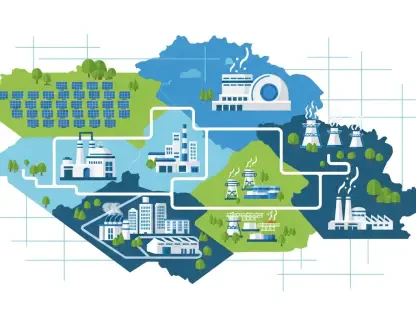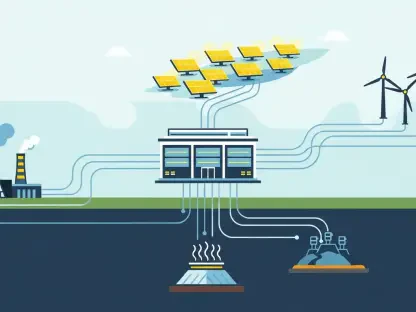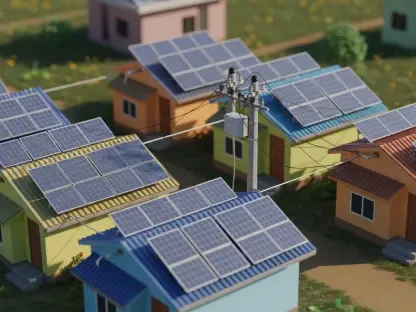In the world of energy management and renewable systems, microgrids have emerged as a critical infrastructure solution, particularly for areas vulnerable to natural disasters like wildfires. Today, we delve into this topic with Christopher Hailstone, an expert in energy management and grid reliability. Christopher provides us with insights into how microgrids offer resilience against power outages and how legislative actions could shape the future of this burgeoning technology.
Could you explain the primary function and benefits of microgrids, especially for areas prone to wildfires like California?
Microgrids are essentially localized grids that can disconnect from the traditional grid to operate autonomously. This characteristic provides significant benefits, especially for areas prone to wildfires, like California. They ensure continuous power supply by utilizing local energy sources, often renewable like solar, combined with storage systems such as batteries. In regions where wildfires can disrupt major power lines, these microgrids act as a critical solution for maintaining electricity, thereby ensuring vital services remain operational during emergencies.
How have recent wildfire events and PSPS in California heightened the demand for microgrids?
The increase in wildfire events and Public Safety Power Shutoffs (PSPS) in California has amplified the call for reliable backup systems like microgrids. Given that these shutdowns can leave thousands of customers without power for extended periods, the demand for self-sufficient power systems that can maintain critical infrastructure has surged. Communities and businesses are increasingly looking to microgrids to secure their power needs, reducing disruptions and economic losses tied to outages.
What role do municipal governments and school districts play in adopting microgrid technologies, and can you provide examples of successful implementations, such as in the Ojai Unified School District?
Municipal governments and school districts are pivotal in adopting microgrid technologies. By implementing these systems, they ensure that critical services remain operational even during power outages. A notable example is the Ojai Unified School District in California, which partnered with Schneider Electric to deploy a microgrid largely powered by solar panels and batteries. This setup not only provides backup power during emergencies but also supports the school’s role as an evacuation site, enhancing community resilience.
How might the budget reconciliation bill currently being discussed in Congress affect the future of clean energy and microgrid projects?
The budget reconciliation bill poses potential challenges for the advancement of clean energy and microgrid projects. If it passes, it could remove key federal support, particularly tax credits that are crucial for funding sustainable energy infrastructures. Such legislative changes might increase the financial burden on projects, possibly slowing down the rate at which new microgrids can be adopted, especially by cash-strapped entities like school districts and municipalities.
Can you explain the implications of potential changes to clean energy tax credits as proposed in the current budget reconciliation bill?
Potential changes in clean energy tax credits could significantly impact project financing. These credits currently allow entities to offset substantial portions of their investment costs. Should they be reduced or eliminated, the financial feasibility of many projects would be affected. Entities may find it more challenging to justify the upfront expense without these economic incentives, possibly delaying or even halting projects that depend on them.
What strategies does Schneider Electric employ to ensure projects qualify for current investment tax credits in light of potential legislative changes?
Schneider Electric employs proactive strategies, such as accelerating project timelines, to ensure qualification for existing investment tax credits. By commencing construction ahead of potential legislative changes, they lock in these credits. This foresight involves strategic planning and procurement, ensuring that they can meet client demands while navigating the uncertainties of legislative shifts.
How does the Inflation Reduction Act of 2022 support tax-exempt entities like city governments and school districts in adopting microgrid technology?
The Inflation Reduction Act of 2022 offers significant support to tax-exempt entities through the “direct pay” framework. This provision allows city governments and school districts to access federal tax incentives directly, bypassing traditional barriers like tax liability. Such support can significantly lower the costs of adopting microgrid technologies, facilitating broader implementation across public sectors.
Could you discuss the potential financial threats and opportunities for microgrid customers in light of recent legislative changes?
Legislative changes can create both threats and opportunities for microgrid customers. While the removal of tax credits is a financial threat, it also opens opportunities to innovate funding solutions, such as leveraging state and local grants or utility rebates. These alternative financing options can help mitigate the impact of federal changes, allowing continued growth in microgrid installations despite challenges.
How do state or local grants and utility rebates support the financing of microgrid projects?
State and local grants, alongside utility rebates, are vital in supporting the financing of microgrid projects. They provide alternative funding sources that can reduce the upfront investment required for microgrid installation. Such financial incentives are crucial, especially when federal support wavers, ensuring that projects remain feasible and appealing to potential adopters.
What potential savings can school districts and municipalities expect from using on-site solar and batteries compared to traditional utility arrangements?
School districts and municipalities can anticipate substantial savings from using on-site solar and battery systems. These setups reduce dependence on traditional utility sources, often leading to lower energy costs. Moreover, they provide protection against utility rate hikes, thereby offering long-term financial benefits coupled with enhanced energy security.
Could you explain energy savings performance contracts (ESPC) and how they assist in mitigating upfront costs for energy-related upgrades?
Energy savings performance contracts (ESPC) are strategic tools that allow entities to implement energy-efficient upgrades without significant upfront costs. Under these contracts, the savings generated from reduced energy consumption are used to finance the initial setup costs. This approach mitigates financial barriers, enabling the implementation of comprehensive energy solutions, including microgrids.
How do direct ownership models compare to energy-as-a-service (EaaS) agreements for microgrid customers?
Direct ownership models and energy-as-a-service (EaaS) agreements offer different advantages for microgrid customers. Direct ownership allows for asset depreciation over time and complete control, while EaaS offers a turnkey solution where customers only pay for the energy used. This flexibility lets customers choose a model that best aligns with their financial and operational needs.
Can you describe Schneider Electric’s EaaS solutions, AlphaStruxure and GreenStruxure, and the types of customers they are designed for?
Schneider Electric’s EaaS solutions, AlphaStruxure and GreenStruxure, cater to different customer needs. AlphaStruxure is ideal for large-scale power users requiring robust capacity, typically industrial customers needing over 5 megawatts. GreenStruxure, meanwhile, targets commercial customers focusing on zero-carbon solutions, making it suitable for businesses that prioritize sustainability and spend over $500,000 annually on electricity.
Beyond direct financial savings, what are some of the indirect benefits of adopting microgrids, particularly for educational and municipal facilities?
Indirect benefits of microgrids include improved operational resilience and reduced disruptions during power outages. For educational and municipal facilities, maintaining operations during power cuts safeguards crucial services and resources. These systems can prevent school closures and ensure that community centers can serve as emergency shelters, enhancing overall public safety and welfare.
How do microgrids contribute to maintaining operations during PSPS events or actual emergencies?
During PSPS events or emergencies, microgrids provide a reliable power source, keeping essential services running. They ensure that crucial facilities like schools, hospitals, and emergency centers remain operational, thus playing a vital role in disaster response and recovery efforts. This capability is indispensable, especially in regions like California where power outages are common.
How do microgrids support the role of schools and municipal facilities as cooling centers or emergency shelters during extreme weather?
Microgrids enable schools and municipal facilities to function as cooling centers or emergency shelters by providing uninterrupted power. This functionality is critical during extreme weather events, ensuring the safety and comfort of vulnerable populations. By maintaining a stable power supply, these facilities can offer refuge and essential services when the wider grid is unavailable.
What is the typical energy source mix for microgrids, and can they be customized according to the user’s sustainability goals?
Microgrids typically integrate various energy sources, including solar, wind, and conventional generators. They offer customization flexibility to meet specific sustainability goals, allowing users to choose an energy mix that aligns with their environmental priorities. This adaptability makes microgrids an attractive option for organizations committed to reducing their carbon footprint.
How flexible are microgrids in incorporating existing backup systems, such as diesel generators, into their framework?
Microgrids provide great flexibility in integrating existing backup systems, like diesel generators, into their framework. This compatibility ensures that customers can enhance their resilience without discarding their current infrastructure. As demonstrated in places like the Ojai Unified School District, such integration provides additional security during multiday outages.
What are some important considerations for facility operators when determining which systems and functions need backup support from microgrids?
Facility operators should carefully evaluate which systems require backup to optimize costs and effectiveness. They should focus on critical functions that need uninterrupted power, such as IT, public works, and emergency services. By identifying and prioritizing these functions, operators can design more efficient and cost-effective microgrid systems.
Why is it crucial to have realistic outage duration and frequency projections when planning a microgrid system?
Having realistic projections of outage duration and frequency is vital to prevent oversizing or undersizing microgrid systems. Accurate estimates ensure that the system is appropriately scaled, offering sufficient resilience without unnecessary expense. This balance is key to maximizing performance and financial viability while ensuring continuous operation during power outages.
What is your forecast for the future of microgrid technology?
The future of microgrid technology appears promising, especially as the demand for resilient energy systems grows. With advancements in renewable energy integration and battery storage, microgrids will become even more efficient and cost-effective. Legislative and financial support can further accelerate their adoption, making them a standard feature in infrastructure planning for both public and private sectors.









